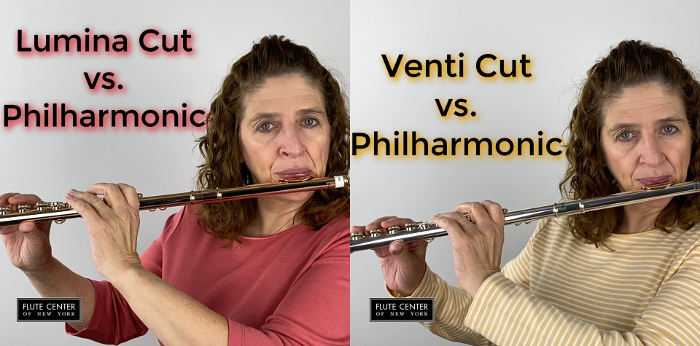The Flute Center of New York sent me 2 gorgeous Powell handmade flutes, and 4 beautiful Powell hand-cut headjoints to compare the cut of their lip plates. Two headjoints are 14K rose gold: 1 headjoint has the Lumina cut, the other has the Philharmonic cut. The other two headjoints are Sterling silver: 1 headjoint has the Venti cut, the other has the Philharmonic cut.
The two 14K rose gold headjoints were compared on the same 14K rose gold flute.
The two Sterling silver headjoints were compared on the same Sterling silver flute.
Wow! What a huge difference between them! Their sound was clearly different. But what was instantly noticeable and distinctly different was their responsiveness and resistance.
Here is how Powell Flutes describes each headjoint:
The Lumina has style and panache. Supple yet responsive, it moves quickly throughout the range with little effort. This headjoint’s clean and energetic sound is the perfect complement to our more classic styles.
The Philharmonic is the iconic Powell sound; rich, deep, and intriguing. Offering the most resistance of all our styles, the Philharmonic features a broad, smooth lip plate reminiscent of the Louis Lot flutes. This style offers an extensive palette of colors which are perfect for blending with other instrument families in a symphony orchestra.
The powerhouse of our headjoint offerings, the Venti style combines the response of the Soloist with the richness of the Philharmonic. This style has a broad lip plate with a steep front angle, producing fantastic response and projection.
Powell Flutes make another cut that I did not test called the Soloist. Here’s it’s description:
With a wide range of dynamics and characteristics, the Soloist is the sports car of headjoints. Sleek and simple with its narrow, curved lip plate, this style is incredibly flexible. Designed for the player who demands precision and performance.
Different Lip Plates Produce Different Sounds
Just to be clear, we are comparing the lip plate on the headjoint. As you know, this is the part of the flute where your mouth makes contact and forms an embouchure to produce many various and beautiful musical sounds with an array of subtle differences in color unsurpassed by any other orchestral instrument (IMHO).
The shape and design of the lip plate has a large impact on your ability to produce some notes, as well as your ability to produce musical colors, or what some refer to as nuance. The differences include the size and shape of the lip plate and the hole, the steepness of the strike edge, the angle on the inside, as well as the metal of the riser. The curvature of the lip plate can even vary!
Professional flutists learn to work with their flute to make beautiful music regardless of the lip plate, or any other characteristic of their flute for that matter. So, do not be concerned about making a wrong choice in headjoint. You can learn to play on a challenging instrument, and you will likely be a better flutist for the effort.
Lumina Cut
Powell describes the Lumina as “supple yet responsive.” I think that is true. It is very, very responsive. It almost is too responsive, if that is possible. But wow it is really gorgeous!
I felt that response, it just pops right out there. The low register is phenomenal. You know what I mean, in that low register, especially after F when you sometimes have that delay – air then sound. Which we all work to get rid of. That is really not a problem with the Lumina!
I’m not even working at it. If I were to pick up my professional model silver Flute when my lip is not quite as warmed up as it could be, I would probably have to really think about it to get my low C to pop right out as it does with this Lumina cut headjoint!
I think it is easy to play. It is very bright, has good volume, and is very resonant. It has a good sharp volume to it. And so, I think it is beautiful. If you are playing a lot of 21st century music and you need that edgy type of sound, maybe the Lumina cut is the one you’re looking for.
Venti Cut
Powell describes the Venti as the “powerhouse” combining richness with responsiveness. Right away I could feel the projection. This headjoint has a big sound that could project through any group in any hall.
The low register seemed responsive. Although I was leaking a bit each time that I played a low C simply because I play on an inline G and this is an offset G. But I feel like the response in the low register is right there – it’s fast. There is no delay.
The third octave was also more responsive than my professional model flute. However, there was more resistance up there, as I cracked some notes. But I like the feel and am sure that after I played around with this headjoint that I would get the feel of it and have no problem up there.
Overall, the sound is bright and a little bit edgy. But it might be a little shrill at the top where I cracked.
Philharmonic Cut
Powell describes the Philharmonic as “offering the most resistance of all our styles.” I can say for certain that there is a huge difference in resistance between these two headjoints!
This begs an interesting question: Why do you want resistance?
Well, my professional model flute is a Haynes. It is the one that I play on. It is supposed to have a quite a bit of resistance. And I love it for that resistance! We want some resistance in our playing because that helps us to work with the sound. It helps the vibrations to be able to change and we can manipulate that to get the different colors that we are looking for.
So, I could tell the difference between the Lumina as soon as I started playing the Philharmonic. That resistance is there, but I kind of like it. I am used to having a little bit of resistance and I like it.
When you have a flute that has a little more resistance, you should not negate it right away. When you play one like the Lumina cut that is so easy, you might be convinced that this is the one for you because it was so easy. And maybe that is for you. Maybe that is what you want. But perhaps you can work with a headjoint like the Philharmonic and learn to achieve the different colors and the sounds that you desire.
When you understand the value of resistance, you will learn to work with things like the angle of your airstream. I would play around with that angle to determine where you will get the best tone. How do you need the strike edge to split the air? You will learn to get the rich warm sounds available.
The Philharmonic produces a darker in sound. The Lumina was brighter. Maybe I can get that brighter sound, but I will have to work at it a little bit. The darker sound is maybe warmer. The Philharmonic cut is what I think of as a typical gold sound. It has a warmer, darker sound. It takes a little bit of work to get that projection. But I hear the power, and I feel it in there too.
So, I felt that the Philharmonic would give me maybe more power, whereas the Lumina, which had a brighter sound, more instantaneous sound, might not have quite as much power. However, I do not think you would have any problem reaching the back of a hall if you did a recital with the Lumina.
My Preference
In the end I liked the resistance of the Philharmonic cut. I think that once I worked on it, that sound would be right there. Once we really warmed up to each other, this one for me would give me what I am looking for. I really enjoy this sound. So, I am not afraid of a little resistance.
So, when you are trying out flutes, try out these two different cuts on the same flute body. You need to decide which is better for you – the one that is right there that is easy to get, or the one that you have to work with it and make it work for you. Which one fits your lifestyle and your practicing habits?
Watch my videos and listen in as I comment on what I hear and feel as I play on each of these headjoints.
Can you hear the differences?
How much resistance do you prefer?
Let me know in the comments which one you think is the better one for me.
Have Fun!
DoctorFlute
Does the Cut of Your Lip Plate Make a Difference on a Professional Gold Flute? FCNY Sponsored

Does the Cut of Your Lip Plate Make a Difference on a Professional Silver Flute – FCNY Sponsored

Here are links to the flutes and headjoints demonstrated in this video:
If you follow these links to The Flute Center of NY, tell them I sent you by putting my code: “DrFlute” in the box labeled “Influencer Code.”
Thanks!
Verne Q. Powell Handmade Custom Flute in 14K Gold
14K rose-gold body with sterling silver mechanism, Powell pinless mechanism, soldered silver tone holes, silver rings, ribs, and posts, French (open hole) model, pointed key arms, white gold springs, Straubinger pads, .012” thin wall tubing, modern Powell scale, offset G, C# trill, D# roller, B footjoint. Handmade in USA.
https://flutecenter.com/collections/shop-by-brand/products/powell-custom-14ksk
Verne Q. Powell 14K Rose Gold Handcut Headjoint – 14K rose gold tube, lip plate, riser, and crown. Lumina cut. Handmade in USA.
Verne Q. Powell 14K Rose Gold Handcut Headjoint – 14K rose gold tube, lip plate, riser, and crown. Philharmonic cut. Handmade in USA.
https://flutecenter.com/products/hj-powell-14k
Verne Q. Powell Handmade Custom Flute in Sterling Silver
Sterling silver body and mechanism, Powell pinless mechanism, soldered silver tone holes, silver rings, ribs, and posts, French (open hole) model, pointed key arms, white gold springs, Straubinger pads, .016” standard wall tubing, modern Powell scale, offset G, C# trill, D# roller, B footjoint. Handmade in USA.
https://flutecenter.com/products/powell-custom-silv
Verne Q. Powell Custom Headjoint in Sterling Silver– Sterling silver tube, 14K gold lip plate and riser, .016” standard wall tubing. Venti cut & Philharmonic cut. Handmade in USA.
https://flutecenter.com/collections/shop-all-flute-headjoints?pf_t_level=Handmade&pf_v_brand=Powell
If you’re interested in setting up a flute trial, please consider FCNY and tell them I sent you (Code: DrFlute) to get some extras for free.
To start your flute trial, you’ll first want to go to flutecenter.com and fill out the form. Here’s the link:
https://flutecenter.com/pages/trial-form
Then put my code: “DrFlute” in the box labeled “Influencer Code.”
This code gives you these extras with some exceptions:
*3 extra days to try your flute – that’s a 10-day trial instead of only 7 days
*6 extra months of warranty on your new flute – that’s 18 months instead of only 12 months
*Free Shipping of up to three flutes, piccolos, and/or headjoints at a time for trial!
*10% off sheet music
*Free domestic shipping on instrument purchases
Plus, when you purchase a new flute using my code, FCNY will pay me a small commission. Thank you!
Thank you, Flute Center of New York, for sponsoring this video.
Why Are Professional Flutes So Expensive? Flute Center Sponsored

Should You Put a Professional Headjoint on an Intermediate Body – FluteTips 170

Finding Your Tone with a New Headjoint – FluteTips 158

The Difference Gold Makes on a Headjoint – FCNY Sponsored

How to Choose a New Headjoint For Your Flute – FluteTips 100

